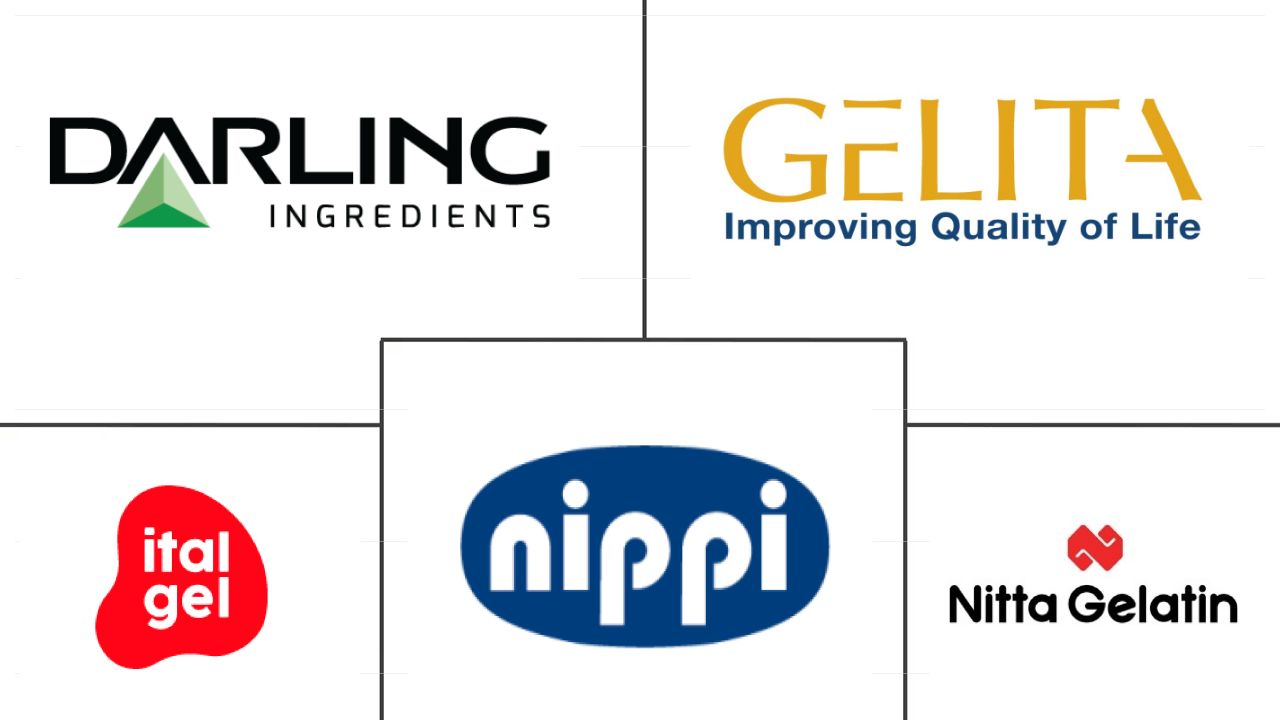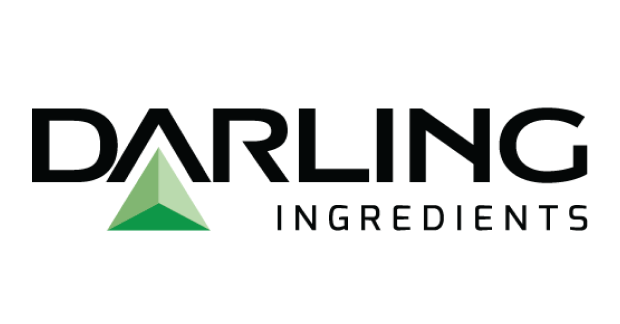Market Size of collagen Industry
| Icons | Lable | Value |
|---|---|---|
|
|
Study Period | 2017 - 2029 |
|
|
Market Size (2024) | USD 1.32 Billion |
|
|
Market Size (2029) | USD 1.78 Billion |
|
|
Largest Share by End User | Food and Beverages |
|
|
CAGR (2024 - 2029) | 6.07 % |
|
|
Largest Share by Region | Asia-Pacific |
|
|
Market Concentration | Low |
Major Players |
||

|
||
|
*Disclaimer: Major Players sorted in no particular order |
Collagen Market Analysis
The Collagen Market size is estimated at 1.32 billion USD in 2024, and is expected to reach 1.78 billion USD by 2029, growing at a CAGR of 6.07% during the forecast period (2024-2029).
1.32 Billion
Market Size in 2024 (USD)
1.78 Billion
Market Size in 2029 (USD)
6.24 %
CAGR (2017-2023)
6.07 %
CAGR (2024-2029)
Largest Market by Form
80.60 %
value share, Animal Based, 2023

With a price half that of marine-based collagen and the ability to accommodate shellfish sensitivities, the segment was able to take the lead in the source category.
Largest Market by End User
95.80 %
value share, Food and Beverages, 2023
The increased demand for healthy foods, especially skin-boosting foods, has surged the collagen demand in the F&B segment, making it a leader in the end-user category.
Fastest Growing Market by Form
7.25 %
Projected CAGR, Marine Based, 2024-2029
High bioavailability, low energy content, and collagen's acceptance as a fat alternative are the major factors expected to contribute toward the fastest growth of the market.
Fastest Growing Market by End User
7.43 %
Projected CAGR, Personal Care and Cosmetics, 2024-2029
Numerous functionalities and the surge in demand for protein-fortified skincare products may propel the growth of the personal care and cosmetics segment in the forecast period.
Leading Market Player
4.55 %
market share, Darling Ingredients Inc., 2021

Darling Ingredients Inc. constantly adopted distinct strategies like reorganizing its brands and products into three new strategic segments that contributed to its market share.
Personal care and cosmetic segment is expected to gain higher sales in forecast period due to growing consumer preferences for collagen-based beauty products i.e. beneficial for skin
- By end user, F&B remained the largest segment, with the majority of applications in the beverage, bakery, and snacks sub-segments. The segment is also anticipated to drive the market with a CAGR of 5.80%, by volume, in the forecast period. This demand can be attributed to its multi-functionality and nutritional benefits.
- However, in the forecast period, collagen application in the personal care and cosmetics segment is projected to outpace other segments with the fastest CAGR of 6.84% by volume. The segment highly uses collagen in the hydrolyzed form, owing to its negligible skin irritation, sensitization, or indication of phototoxicity. Protein fortification has become a major interest among global consumers, with a rise in their health concerns. For example, in 2021, 75% of global consumers paid a higher price for protein-fortified food and beverages, while more than half paid a 10% premium, and 15% of consumers would be willing to pay a 25% premium.
- The beverages sub-segment is the largest end-user segment in the collagen market and represents over 41.6% of the total consumption volume in 2022. The collagen drinks market is in its early stages of development. As consumers become increasingly aware of the health benefits of the beverages they consume, it may result in an increase in the overall market for collagen drinks. Collagen-based drinks are high in hydroxyproline, amino acids glycine, arginine, and proline, which are associated with energy supply, cell regeneration, and metabolism. Collagen can be used in many hot beverages, which paves the way for innovative products with health benefits. Hence, the consumption of collagen-enhanced hot beverages such as coffee and hot chocolate is increasing at a high pace.
Asia-pacific accounted majority of share in 2022 due to growing popularity of collagen based products coupled with strong presence of various manufacturing units
- The Asia-Pacific collagen market is the largest, owing to the higher production of raw materials in the region, mainly in China and India. In China, collagen application in supplements is not only used for skin beauty but also beneficial for immune, joint health, and sports performance. Collagen sales in the region are being driven by the aging population and companies that are progressively adding collagen-based ingredients to their product lines. In Southeast Asia, the proportion of individuals aged 60 years and older was 9.8% in 2017, which is projected to rise to 13.7% by 2030.
- Europe is the second-largest regional segment for the market and is also projected to record the fastest CAGR of 6.48%, by value, during the forecast period, attributed to a rise in regional players catering to the surging demand by adopting distinct strategies like constant product innovation for highly potential end-user segments, like personal care and cosmetics. The growing popularity of collagen-based beauty drinks and collagen peptide-based beverages like Sanotact and BeautyHacker beauty collagen drinks in Germany contributes to this growth.
- Middle East & Africa is another promising market, as most consumers follow Islamic principles, thus creating opportunities for market players in the region to supply collagen sourced from halal sources or marine-based collagen/ With the introduction and implementation of religion-based policies, the demand is anticipated to increase, primarily to render flexibility for using collagen-based products. The marine-sourced collagen market in the Middle East and African regions is projected to record a CAGR of 7.47% and 8.21%, respectively, during the forecast period.
Collagen Industry Segmentation
Animal Based, Marine Based are covered as segments by Form. Animal Feed, Food and Beverages, Personal Care and Cosmetics, Supplements are covered as segments by End User. Africa, Asia-Pacific, Europe, Middle East, North America, South America are covered as segments by Region.
- By end user, F&B remained the largest segment, with the majority of applications in the beverage, bakery, and snacks sub-segments. The segment is also anticipated to drive the market with a CAGR of 5.80%, by volume, in the forecast period. This demand can be attributed to its multi-functionality and nutritional benefits.
- However, in the forecast period, collagen application in the personal care and cosmetics segment is projected to outpace other segments with the fastest CAGR of 6.84% by volume. The segment highly uses collagen in the hydrolyzed form, owing to its negligible skin irritation, sensitization, or indication of phototoxicity. Protein fortification has become a major interest among global consumers, with a rise in their health concerns. For example, in 2021, 75% of global consumers paid a higher price for protein-fortified food and beverages, while more than half paid a 10% premium, and 15% of consumers would be willing to pay a 25% premium.
- The beverages sub-segment is the largest end-user segment in the collagen market and represents over 41.6% of the total consumption volume in 2022. The collagen drinks market is in its early stages of development. As consumers become increasingly aware of the health benefits of the beverages they consume, it may result in an increase in the overall market for collagen drinks. Collagen-based drinks are high in hydroxyproline, amino acids glycine, arginine, and proline, which are associated with energy supply, cell regeneration, and metabolism. Collagen can be used in many hot beverages, which paves the way for innovative products with health benefits. Hence, the consumption of collagen-enhanced hot beverages such as coffee and hot chocolate is increasing at a high pace.
| Form | |
| Animal Based | |
| Marine Based |
| End User | ||||||||
| Animal Feed | ||||||||
| ||||||||
| Personal Care and Cosmetics | ||||||||
|
| Region | |||||||||||||||||
| |||||||||||||||||
| |||||||||||||||||
| |||||||||||||||||
| |||||||||||||||||
| |||||||||||||||||
|
Collagen Market Size Summary
The collagen market is experiencing significant growth, driven by its diverse applications across various industries. The food and beverage sector remains the largest end-user, with collagen being extensively used in beverages, bakery products, and snacks due to its multifunctional and nutritional benefits. However, the personal care and cosmetics segment is projected to grow at a faster rate, as collagen in hydrolyzed form is favored for its minimal skin irritation and phototoxicity. The increasing consumer interest in protein fortification, coupled with rising health consciousness, is further propelling the demand for collagen-based products. The market is witnessing a surge in collagen-enhanced beverages, particularly in the Asia-Pacific region, where the availability of raw materials and a growing aging population are key factors driving market expansion.
Regionally, the Asia-Pacific holds the largest share of the collagen market, with China and India leading in production. The region's market growth is supported by the aging population and the incorporation of collagen in various health and beauty products. Europe follows as the second-largest market, with a notable growth rate attributed to regional players innovating to meet the demand in personal care and cosmetics. The Middle East and Africa present promising opportunities, especially with the increasing demand for halal and marine-sourced collagen. The market is fragmented, with major players like Darling Ingredients Inc., GELITA AG, Italgelatine SpA, Nippi. Inc., and Nitta Gelatin Inc. actively expanding their product offerings and production capabilities to capture a larger market share.
Collagen Market Size - Table of Contents
-
1. MARKET SEGMENTATION (includes market size in Value in USD and Volume, Forecasts up to 2029 and analysis of growth prospects)
-
1.1 Form
-
1.1.1 Animal Based
-
1.1.2 Marine Based
-
-
1.2 End User
-
1.2.1 Animal Feed
-
1.2.2 Food and Beverages
-
1.2.2.1 By Sub End User
-
1.2.2.1.1 Bakery
-
1.2.2.1.2 Beverages
-
1.2.2.1.3 Breakfast Cereals
-
1.2.2.1.4 Snacks
-
-
-
1.2.3 Personal Care and Cosmetics
-
1.2.4 Supplements
-
1.2.4.1 By Sub End User
-
1.2.4.1.1 Elderly Nutrition and Medical Nutrition
-
1.2.4.1.2 Sport/Performance Nutrition
-
-
-
-
1.3 Region
-
1.3.1 Africa
-
1.3.1.1 By Form
-
1.3.1.2 By End User
-
1.3.1.3 By Country
-
1.3.1.3.1 Nigeria
-
1.3.1.3.2 South Africa
-
1.3.1.3.3 Rest of Africa
-
-
-
1.3.2 Asia-Pacific
-
1.3.2.1 By Form
-
1.3.2.2 By End User
-
1.3.2.3 By Country
-
1.3.2.3.1 Australia
-
1.3.2.3.2 China
-
1.3.2.3.3 India
-
1.3.2.3.4 Indonesia
-
1.3.2.3.5 Japan
-
1.3.2.3.6 Malaysia
-
1.3.2.3.7 New Zealand
-
1.3.2.3.8 South Korea
-
1.3.2.3.9 Thailand
-
1.3.2.3.10 Vietnam
-
1.3.2.3.11 Rest of Asia-Pacific
-
-
-
1.3.3 Europe
-
1.3.3.1 By Form
-
1.3.3.2 By End User
-
1.3.3.3 By Country
-
1.3.3.3.1 Belgium
-
1.3.3.3.2 France
-
1.3.3.3.3 Germany
-
1.3.3.3.4 Italy
-
1.3.3.3.5 Netherlands
-
1.3.3.3.6 Russia
-
1.3.3.3.7 Spain
-
1.3.3.3.8 Turkey
-
1.3.3.3.9 United Kingdom
-
1.3.3.3.10 Rest of Europe
-
-
-
1.3.4 Middle East
-
1.3.4.1 By Form
-
1.3.4.2 By End User
-
1.3.4.3 By Country
-
1.3.4.3.1 Iran
-
1.3.4.3.2 Saudi Arabia
-
1.3.4.3.3 United Arab Emirates
-
1.3.4.3.4 Rest of Middle East
-
-
-
1.3.5 North America
-
1.3.5.1 By Form
-
1.3.5.2 By End User
-
1.3.5.3 By Country
-
1.3.5.3.1 Canada
-
1.3.5.3.2 Mexico
-
1.3.5.3.3 United States
-
1.3.5.3.4 Rest of North America
-
-
-
1.3.6 South America
-
1.3.6.1 By Form
-
1.3.6.2 By End User
-
1.3.6.3 By Country
-
1.3.6.3.1 Argentina
-
1.3.6.3.2 Brazil
-
1.3.6.3.3 Rest of South America
-
-
-
-
Collagen Market Size FAQs
How big is the Global Collagen Market?
The Global Collagen Market size is expected to reach USD 1.32 billion in 2024 and grow at a CAGR of 6.07% to reach USD 1.78 billion by 2029.
What is the current Global Collagen Market size?
In 2024, the Global Collagen Market size is expected to reach USD 1.32 billion.

